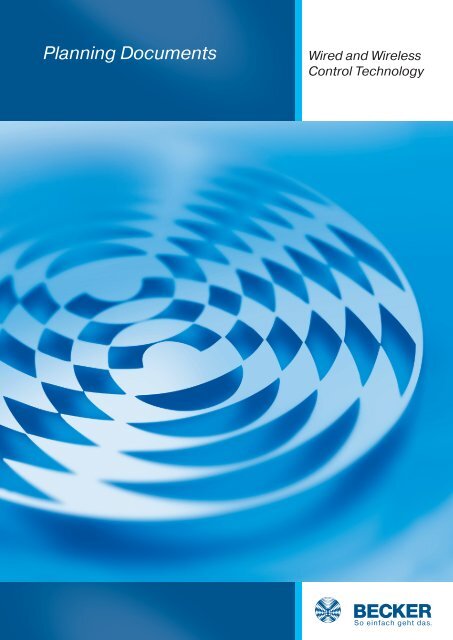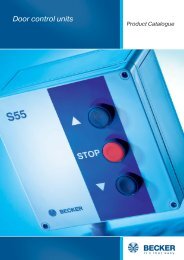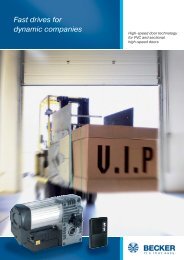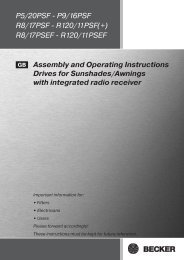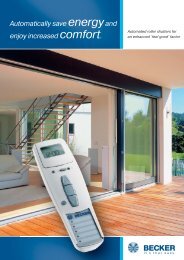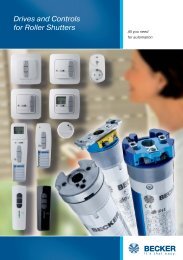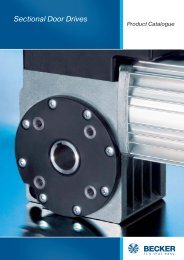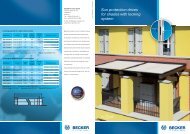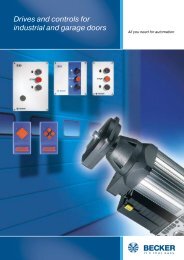Wireless Technology - Becker-Antriebe
Wireless Technology - Becker-Antriebe
Wireless Technology - Becker-Antriebe
Create successful ePaper yourself
Turn your PDF publications into a flip-book with our unique Google optimized e-Paper software.
Planning Documents<br />
Wired and <strong>Wireless</strong><br />
Control <strong>Technology</strong>
Table of Contents<br />
Wired <strong>Technology</strong><br />
Overview. ...................................................................................................................... 4<br />
Synchronous control of numerous drives.................................................................................................6<br />
Multiple control relay.............................................................................................................................8<br />
Central, group and individual control..................................................................................................... 10<br />
Central, group and individual control with the low-voltage central cable................................................... 12<br />
Sun-wind control unit with the low-voltage central cable......................................................................... 14<br />
Sun-wind automatic unit with rain and temperature monitoring inside and outside.................................... 16<br />
<strong>Wireless</strong> <strong>Technology</strong><br />
Overview transmitters..................................................................................................... 18<br />
Overview receivers........................................................................................................ 20<br />
Overview SunWindSets................................................................................................... 22<br />
Principle: Formation of individual, group and central controls .................................................. 23<br />
Principle: Formation of individual, group and central controls..................................................................24<br />
Individual and group control with memory function.................................................................................25<br />
Central, group and individual control with multi-channel handheld transmitter and central timer.................26<br />
Central, group and individual control via a timer in the handheld transmitter with display and sun-twilight<br />
function via the radio-controlled light sensor.......................................................................................... 27<br />
Central, group and individual control via a timer in the handheld transmitter with display, sun-twilight<br />
function via the radio-controlled light sensor for drives with internal and external receivers........................28<br />
Principle of the radio-controlled sun-wind controls................................................................ 30<br />
Safety due to permanent monitoring.................................................................................. 30<br />
Installation and operating range in the building structure..........................................................31<br />
Central and group control with the SunWindSet SWS241<br />
and an additional 5-channel handheld transmitter EC545.......................................................................32<br />
Individual and central control with the SunWindSet SWS441<br />
and an additional 5-channel handheld transmitter EC545.......................................................................34<br />
Individual and central control with the SunWindSet SWS641<br />
and an additional 5-channel handheld transmitter EC545.......................................................................35<br />
Individual, group and central control with the sun-wind control unit in the handheld transmitter<br />
with display SWC545 and the radio-controlled sun-wind sensor SC861....................................................36<br />
Radio-controlled sun-wind control with integrated dimmer function......................................................... 37<br />
Project planning list........................................................................................................ 38<br />
3
Wired <strong>Technology</strong><br />
Overview<br />
• For roller shutters and sun protection<br />
• Numerous drives<br />
• One control point<br />
• Synchronous control<br />
A parallel connection is still considered the simplest method to interconnect<br />
various drives. This entails several drives being controlled synchronously<br />
via one control point.<br />
Drives with mechanical limit switches should never be connected directly<br />
in parallel. In order to prevent damage to the limit switches, each drive<br />
has to be decoupled via an isolating relay.<br />
Drives with electronic limit switches have a built-in relay and can, therefore,<br />
be connected directly in parallel to the control point.<br />
Isolating relay<br />
TR1<br />
• For roller shutters and sun protection<br />
• Numerous drives<br />
• Individual, group and central control<br />
• Deadman control<br />
When using a multiple control relay it is possible to operate drives via<br />
individual switches, group switches or via a central control unit. The individual<br />
and group commands are not intended for self-locking mode.<br />
All the wired drive control units from the Centronic product range can be<br />
applied as central control units.<br />
Multiple<br />
control<br />
relay<br />
• For roller shutters and sun protection<br />
• Numerous drives<br />
• Individual, group and central control<br />
• Self-locking mode<br />
The automatic control unit UnitControl UC42 enables the convenient<br />
control of drives in self-locking mode. A simple connection allows you to<br />
construct as many individual, group and central control systems as you<br />
desire. All the wired drive control units from the Centronic product range<br />
can be applied as central control units.<br />
UnitControl<br />
UC42<br />
4
Wired <strong>Technology</strong><br />
• For roller shutters and sun protection<br />
• Numerous drives<br />
• Individual, group and central control<br />
• High-level of operating convenience<br />
Centronic products offer the highest level of operating convenience.<br />
Connected through the low-voltage central cable, individual, group,<br />
and central commands can be given to the different units. The signals<br />
are transmitted through the low-voltage central cable and interpreted,<br />
processed and executed by the downstream devices. Furthermore, it is<br />
possible to move roller shutters or awnings to exactly defined intermediate<br />
positions via an automatic command (time or light controlled). The<br />
central commands can be deactivated at any time via a sliding switch.<br />
Nonetheless, emergency commands for protecting the system (e.g.<br />
wind alarm) are still recognized and executed.<br />
UnitControl<br />
UC52<br />
• For roller shutters<br />
• Numerous drives<br />
• Individual, group and central control<br />
• High-level of operating convenience<br />
TC42 is a typical roller shutter timer including an astro-evening programme.<br />
Operation and blocking times for the astro programme are set<br />
up in the so called unitary program (workdays and weekend represent a<br />
separate unit).<br />
TC52 is the all-rounder amongst roller shutter timers. In addition to the<br />
astro programme for morning and evening, 4 separate programmable<br />
slots for each day or the ability to connect a light sensor (LS43), the<br />
TC52 is also capable of controlling the low-voltage central cable or remotely<br />
being controlled by it.<br />
TimeControl<br />
TC42<br />
TimeControl<br />
TC52<br />
• For sun protection<br />
• Numerous drives<br />
• Individual, group and central control<br />
• High-level of operating convenience<br />
The SunWindSet SWS42 consists of the SunWindControl SWC52 and the<br />
sensor SC81. Sun intensity levels for automatic extension and retraction<br />
can be regulated individually. Time delays are programmable as well.<br />
The user can define operating and blocking times, thereby de-activating<br />
the automatic sun protection function. SWC52 is also capable of controlling<br />
the low-voltage central cable or remotely being controlled by it.<br />
SC81<br />
SunWindSet<br />
SWS42<br />
SunWindControl<br />
SWC52<br />
5
Wired <strong>Technology</strong><br />
Synchronous Control of Numerous Drives<br />
This application enables the synchronous control of numerous drives via a<br />
roller shutter timer TC42. Individual control of the roller shutters is not possible<br />
in this case.<br />
Always ensure that each drive is decoupled via an isolating relay when<br />
using drives with mechanical limit switches. All <strong>Becker</strong> drives with electronic<br />
limit switches have a built-in relay and can, therefore, be simply and<br />
cost-effectively connected directly in parallel. The maximum number of<br />
synchronously controlled drives should, depending on the actual current<br />
consumption, not be more than five.<br />
All the wired drive control units from the Centronic product range can be<br />
applied as the central control unit.<br />
TC42<br />
2x<br />
TR1<br />
3x<br />
6
Wired <strong>Technology</strong><br />
Connecting Diagram<br />
7
Wired <strong>Technology</strong><br />
Multiple Control Relay<br />
A multiple control relay can be used to synchronously control two drives<br />
with mechanical limit switches.<br />
By interconnecting several multiple control relays it is possible to realize<br />
individual, group and central controls.<br />
Control via the switches always occurs in deadman mode. The switches<br />
must not be able to execute simultaneous UP and DOWN commands<br />
(mechanically or electrically locked switches).<br />
The central command has the highest priority.<br />
All the wired drive control units from the Centronic product range can be<br />
applied as the central control unit.<br />
TC42<br />
1x<br />
Multiple<br />
control relay<br />
4x<br />
8
Wired <strong>Technology</strong><br />
Connecting Diagram<br />
9
Wired <strong>Technology</strong><br />
Central, Group and Individual Control<br />
One of the simplest ways to realize individual, group and central controls is<br />
via the Centronic UnitControl UC42. The roller shutters can be conveniently<br />
controlled in self-locking mode via the switches. The individual and central<br />
commands are created by applying the voltage L (230V/50Hz). This ensures<br />
that a separate central cable is unnecessary. The power supply and<br />
central commands can be realized via a common NYM 5x1.5 cable. Every<br />
type of commercially available up/down or serial switch is suitable for the<br />
tasks at hand.<br />
The central command has the highest priority.<br />
All the wired drive control units from the Centronic product range can be<br />
applied as the central control unit.<br />
TC42<br />
1x<br />
UC42<br />
4x<br />
10
Wired <strong>Technology</strong><br />
Connecting Diagram<br />
11
Wired <strong>Technology</strong><br />
Central, Group and Individual Control<br />
with the Low-Voltage Central Cable<br />
This example describes a typical realization of an individual, group and<br />
central control via the low-voltage control cable. The control units (TC52,<br />
UC52 as well as UC520 and SWC52) can be used to activate the central<br />
cable or to control drives. In this case, only a JYSTY cable 2x2x08 is necessary<br />
as a central cable.<br />
The central command can be individually switched off via the manual/automatic<br />
sliding switch at the operating unit. The control units are able to differentiate<br />
between numerous control commands at the low-voltage central<br />
cable. This enables exact stopping at individual intermediate positions or<br />
the execution of a higher-level emergency signal. For example, the signal<br />
LED at the operating unit displays an existing emergency signal.<br />
TC52<br />
1x<br />
UC52<br />
4x<br />
12
Wired <strong>Technology</strong><br />
Connecting Diagram<br />
The operating mode “Group Control Unit” or “Drive Control Unit” is selected via a DIP switch located at the rear of the operating unit of UC52 (UC520).<br />
In the case of TC52 (SWC52) the operating mode can be defined via the “Function” menu item “Programming”. When applied as a group control unit,<br />
there should not be a bridge between terminals L and C.<br />
13
Wired <strong>Technology</strong><br />
Sun-Wind Control Unit<br />
with the Low-Voltage Central Cable<br />
The sun-wind control unit SWC52 with the sensory equipment SC81 is used<br />
in the entire sun protection sector. The SWC52 can be used to activate the<br />
low-voltage central cable or to control drives. As a central control cable between<br />
the different control units only a JYSTY cable 2x2x08 is necessary.<br />
Numerous control commands are switched to the central cable via the<br />
SWC52. These commands are then executed by the downstream control<br />
units. This ensures that the individual awnings can be automatically moved<br />
to their intermediate positions to provide sun protection.<br />
SWC52<br />
SWS42<br />
1x<br />
SC81<br />
UC52<br />
4x<br />
14
Wired <strong>Technology</strong><br />
Connecting Diagram<br />
The operating mode “Group Control Unit” or “Drive Control Unit” is selected via a DIP switch located at the rear of the operating unit of UC52 (UC520).<br />
In the case of SWC52 (TC52) the operating mode can be defined via the “Function” menu item “Programming”. When applied as a group control unit,<br />
there should not be a bridge between terminals L and C.<br />
15
Wired <strong>Technology</strong><br />
Sun-Wind Automatic Unit with Rain<br />
and Temperature Monitoring<br />
Inside and Outside.<br />
In addition to sun-wind monitoring this example also monitors the room<br />
temperature, rain and frost.<br />
The room thermometer RTR prevents an extension of the awnings if the<br />
room temperature is too low. The display shows the sun value . The temperature<br />
threshold value can be continuously adjusted.<br />
The awnings are retracted when it starts to rain. The display shows the wind<br />
value . Awning extension is subsequently blocked until it stops raining<br />
(emergency signal). The rain sensor still has an integrated temperature<br />
sensor. This ensures that the awnings are protected against rain and frost.<br />
SWC52<br />
SWS42<br />
1x<br />
SC81<br />
UC52<br />
4x<br />
Evaluation<br />
device<br />
1x<br />
Rain<br />
sensor<br />
1x<br />
RTR<br />
1x<br />
16
Wired <strong>Technology</strong><br />
Connecting Diagram<br />
The operating mode “Group Control Unit” or “Drive Control Unit” is selected via a DIP switch located at the rear of the operating unit of UC52 (UC520).<br />
In the case of SWC52 (TC52) the operating mode can be defined via the “Function” menu item “Programming”. When applied as a group control unit,<br />
there should not be a bridge between terminals L and C.<br />
17
<strong>Wireless</strong> <strong>Technology</strong><br />
Overview Transmitters<br />
• For roller shutters and sun protection<br />
• Individual, group or central control<br />
• Wall-mounted or handheld transmitter<br />
1 or 5 channels<br />
In the case of the EC211, travel commands are transmitted via one single<br />
button with the switching sequence Up/Stop/Down/Stop. The EC311<br />
has three individual buttons for the functions Up, Stop and Down.<br />
Via the group switch at the EC545 it is possible to select between 5 different<br />
individual or group commands. In addition, a central command<br />
can be transmitted.<br />
EC211<br />
EC311<br />
EC541<br />
EC545<br />
• For roller shutters<br />
• Individual, group or central control<br />
• Wall-mounted or handheld transmitter with memory<br />
function<br />
The memory function in the radio-controlled drives and external receivers<br />
for roller shutter/blind applications can be activated or programmed<br />
via the handheld/wall-mounted transmitter MC411 and MC441.<br />
MC411<br />
MC441<br />
• For roller shutters/blinds<br />
• Individual, group or central control<br />
• Wall-mounted or handheld transmitter with highlevel<br />
of operating convenience (astro function,<br />
several switching times per day, sun protection,<br />
twilight function, etc.)<br />
The TC511 is a wall-mounted transmitter with an integrated roller shutter/<br />
blind timer for the greatest operating convenience. The 5-channel handheld<br />
transmitter TC445 with integrated roller shutter/blind timer is designed for the<br />
individual and group control of radio-controlled drives and radio receivers.<br />
TC511<br />
TC445<br />
• For sun protection applications<br />
• Individual, group or central control<br />
• Wall-mounted or handheld transmitter with highlevel<br />
of operating convenience (threshold value setting,<br />
radio controlled dimmer, displays, etc.)<br />
The handheld/wall-mounted transmitters are used to simply set the sun and<br />
wind threshold values in the receiver. The automatic function can be deactivated<br />
via the manual/automatic switch. The handheld transmitter SWC442<br />
is also equipped with a button for controlling a radio-controlled dimmer.<br />
The SWC545 is a 5-channel handheld transmitter with integrated wind<br />
and sunshade control for the individual and group control of radio-controlled<br />
sun protection drives and radio receivers.<br />
SWC411 SWC441 SWC442 SWC545<br />
18
<strong>Wireless</strong> <strong>Technology</strong><br />
• For roller shutters/blinds<br />
• Light and glass-break sensor with high level of automation<br />
The SC431 is a light sensor for window panes. The sun and twilight<br />
threshold values can both be set via potentiometers. The coloured LED<br />
displays whether the current measured light value is above, below or<br />
equal to the set light value. The roller shutter can be operated via an Up/<br />
Stop/Down button. The sun protection or twilight function can be deactivated<br />
via the manual/automatic switch.<br />
SC431<br />
• For sun protection<br />
• Sun-Wind sensor<br />
• Self monitoring<br />
The sun-wind sensors SC811 and SC861 can be programmed to one or<br />
several receivers for sun protection applications. The SC861 is, thanks<br />
to its solar panel, completely mains independent. A rain sensor can be<br />
connected to the SC811.<br />
SC811<br />
SC861<br />
• For special applications<br />
• Individual, group or central control<br />
The external transmitter VC421 is used to convert wired switching signals<br />
into radio signals (e.g. key-operated switch, series switch, external<br />
controls, etc.). The device can be combined with the switches of all<br />
switch programmes.<br />
VC421<br />
19
<strong>Wireless</strong> <strong>Technology</strong><br />
Overview Receivers<br />
• For roller shutters<br />
• Individual, group or central control<br />
• Memory function can be activated<br />
• Intermediate positions can be programmed<br />
End positions and intermediate positions are simply programmed via a<br />
transmitter. With existing buffers (rigid safety spring, stopper or angle<br />
trim) the drive itself programs the final positions automatically. The drive<br />
can be operated via all Centronic transmitters for roller shutter/blind applications.<br />
P5/16PRF+ - P9/16PRF+<br />
R8/17PRF+ - R40/17PRF+<br />
• For sun protection<br />
• Individual, group or central control<br />
• Saves wind and sun threshold values<br />
• Intermediate positions can be programmed<br />
End positions and intermediate positions are simply programmed via a<br />
transmitter. With an existing upper buffer the drive programs the final<br />
positions automatically. The drive is equipped with evaluation electronics<br />
for sun and wind values. The drive can be operated via all Centronic<br />
transmitters and radio sensors for sun protection applications.<br />
P5/20PSF - P9/16PSF<br />
R8/17PSF - R50/11PSF(+)<br />
R44/14PSF(+) - R120/11PSF(+)<br />
• For roller shutters and sun protection<br />
• Individual, group or central control<br />
• Saves wind and sun threshold values<br />
• Memory function can be activated<br />
• Intermediate positions can be programmed<br />
• For special applications<br />
The external radio receivers VC410, VC420, VC520 turn conventional<br />
drives into radio-controlled drives for roller shutter and sun protection<br />
systems.<br />
Wired switches can also be connected to the VC410 and VC420.<br />
VC410<br />
VC420<br />
VC520<br />
• For Roller shutters<br />
• Individual, group or central control<br />
• Memory function can be activated<br />
• Intermediate positions can be programmed<br />
The external radio receiver VC320 is used to turn conventional drives<br />
into radio-controlled drives for roller shutter applications. The VC320 is<br />
designed for installation in box systems and front-mounted boxes.<br />
VC320<br />
20
<strong>Wireless</strong> <strong>Technology</strong><br />
• For sun protection (Venetian blinds)<br />
• Individual, group or central control<br />
• Intermediate positions can be programmed<br />
• Saves wind and sun threshold values<br />
The external radio receiver VCJ470 is used to retrofit radio technology to<br />
conventional drives. The VCJ470, typically found in Venetian blind applications,<br />
is simply placed between an already existing Hirschmann connector<br />
(STAK3N/STAS3N).<br />
VCJ470<br />
• Radio-controlled light dimmer<br />
The radio-controlled light dimmer VC220 is used to dim bulbs and halogen<br />
lamps. When dimming awning halogen lamps the VC220 is positioned<br />
in the awning next to the halogen switching power supply.<br />
VC220<br />
• For sun protection<br />
• Sun-Wind sensor<br />
• Integrated control unit<br />
The SunWindControl SWC510 is a sun-wind sensor with integrated radio<br />
receiver and an integrated control unit for controlling existing tubular<br />
drives. The mains connection cable and the motor cable are connected<br />
directly to the SWC510. Therefore, the SWC510 is the ideal solution for<br />
retrofitting existing systems with radio control. Operation can be carried<br />
out via all Centronic transmitters for sun protection applications.<br />
SWC510<br />
• For roller shutters (UCR520) and sun protection<br />
(UCS520)<br />
• Individual, group or central control<br />
• High-level of operating convenience<br />
The Unit Control UCR520/UCS520 controls either a drive (drive control<br />
unit) or is integrated in the low voltage central cable (group control unit).<br />
Due to the combination of operating elements and an integrated radio<br />
receiver, the UCR520/UCS520 is mainly used for retrofitting existing<br />
drives with radio control.<br />
The UCR520 is compatible with all Centronic roller shutter transmitters.<br />
The UCS520 is compatible with all Centronic sun protection transmitters.<br />
UnitControl<br />
UCS520<br />
UnitControl<br />
UCR520<br />
21
<strong>Wireless</strong> <strong>Technology</strong><br />
Overview SunWindSets<br />
• For sun protection<br />
• Sun-Wind sensor<br />
• Integrated control unit<br />
• Handheld transmitter with high-level of operating<br />
convenience (threshold value setting)<br />
The SunWindSet SWS241 is a combination of the sun-wind sensor with<br />
integrated receiver SWC510 and the handheld transmitter with threshold<br />
value setting SWC441.<br />
SWC510<br />
SunWindSet<br />
SWS241<br />
SWC441<br />
• For sun protection<br />
• Radio-controlled sun-wind sensor<br />
• Handheld transmitter with high-level of operating<br />
convenience (threshold value setting)<br />
The SunWindSet SWS441 is a combination of the sun-wind sensor SC811<br />
and the handheld transmitter with threshold value setting SWC441.<br />
SunWindSet<br />
SWS441<br />
SC811<br />
SWC441<br />
• For sun protection<br />
• Radio-controlled sun-wind sensor (solar powered)<br />
• Handheld transmitter with high-level of operating<br />
convenience (threshold value setting)<br />
The SunWindSet SWS641 is a combination of the mains-independent<br />
sun-wind sensor SC861 and the handheld transmitter with threshold<br />
value setting SWC441.<br />
SunWindSet<br />
SWS641<br />
SC861<br />
SWC441<br />
22
<strong>Wireless</strong> <strong>Technology</strong><br />
Principle: Formation of individual, group and central controls<br />
Each radio receiver has one storage space for a master transmitter and 15 storage spaces for additional transmitters.<br />
The master transmitter is programmed via the programming button after bringing the drive into learning mode<br />
through the radio switches on the motor head or via a “Power On”. All other transmitters are programmed in the<br />
receiver with the aid of the master transmitter. By programming a transmitter to several drives it is possible to create<br />
a group or central transmitter.<br />
Example:<br />
Individual transmitter A (master transmitter) controls drive 1<br />
Individual transmitter B (master transmitter) controls drive 2<br />
Individual transmitter C (master transmitter) controls drive 3<br />
Group transmitter d controls drive 1 and 2<br />
Group transmitter e controls drive 2 and 3<br />
Central transmitter f controls drive 1, drive 2 and drive 3<br />
23
<strong>Wireless</strong> <strong>Technology</strong><br />
Principle: Formation of individual, group and central controls<br />
With a 5-channel transmitter each individual channel behaves as a separate transmitter. If all the channels are selected<br />
(all group LEDs light up), all the receivers, in which the transmitter has been programmed, are addressed.<br />
Example:<br />
Channel 1 - “Individual transmitter A” (master transmitter) controls drive 1<br />
Channel 2 - “Individual transmitter B” (master transmitter) controls drive 2<br />
Channel 3 - “Individual transmitter C” (master transmitter) controls drive 3<br />
Channel 4 - “Group transmitter d” controls drive 1 and 2<br />
Channel 5 - “Group transmitter e” controls drive 2 and 3<br />
Channel 6 - “Central transmitter” (all group LEDs light up) controls drive 1, drive 2 and drive 3<br />
24
<strong>Wireless</strong> <strong>Technology</strong><br />
Individual and group control with<br />
memory function<br />
In this application, several drives are individually controlled via the 1-channel<br />
handheld transmitter EC541 (master transmitter A, B, C). The wallmounted<br />
transmitter with memory function MC411 (group transmitter d)<br />
controls the drives as a group control. Each drive has an integrated timer<br />
with memory function. This can be de-/activated and programmed via the<br />
MC411.<br />
MC441<br />
EC541<br />
25
<strong>Wireless</strong> <strong>Technology</strong><br />
Central, group and individual control with<br />
multi-channel handheld transmitter and<br />
central timer<br />
In this example, the drives are operated via the 5-channel handheld transmitter<br />
EC545 with central, group and individual control. The channels 1-3<br />
are used as individual transmitters (master transmitter A, B, C). The two<br />
central drives are controlled via channel 4 (group transmitter d), channel 5<br />
remains free. All the drives are controlled synchronously (central transmitter)<br />
via the central function (all channels selected).<br />
A central timer is additionally programmed in all the drives. This also fulfils<br />
the function of a central transmitter and can carry out a number of automatic<br />
commands.<br />
TC511<br />
1x<br />
EC545<br />
1x<br />
26
<strong>Wireless</strong> <strong>Technology</strong><br />
Central, group and individual control via a<br />
timer in the handheld transmitter with<br />
display and sun-twilight function via the<br />
radio-controlled light sensor<br />
The drives are controlled in central, group and individual operation via a<br />
timer in the handheld transmitter with display TC445. The channels 1-3 are<br />
used as individual transmitters (master transmitter A, B, C). The two central<br />
drives are controlled via channel 4 (group transmitter d), channel 5 remains<br />
free. All the drives are controlled synchronously (central transmitter) via the<br />
central function (all channels selected). The integrated timer also controls<br />
the drives via the central function.<br />
A radio-controlled light sensor controls the two central drives (group transmitter<br />
e). In automatic mode (sun protection) the drives stop at the intermediate<br />
position programmed in the drive. If the intermediate position is<br />
below the sensor, the drive stops at “sensor height” (individual transmitter<br />
f).<br />
SC431<br />
1x<br />
TC445<br />
1x<br />
Note: Only program the SC431 into drives in directly adjacent windows (when used as a group transmitter). To<br />
utilise the integrated glass-break sensor, all the affected windows must be equipped with an SC431 (individual<br />
transmitter).<br />
27
<strong>Wireless</strong> <strong>Technology</strong><br />
Central, group and individual control via a<br />
timer in the handheld transmitter with display,<br />
sun-twilight function via the radio-controlled<br />
light sensor for drives with internal and<br />
external receivers<br />
With the external radio receiver VC420 it is possible to retrofit conventional<br />
drives with radio technology. The creation of individual, group and central<br />
transmitters is identical to the PRF+ drives. An additional switch input at the<br />
VC420 enables operation via an external Up-Down switch.<br />
SC431<br />
1x<br />
TC445<br />
1x<br />
VC420<br />
1x<br />
28
<strong>Wireless</strong> <strong>Technology</strong><br />
Connecting diagram<br />
29
<strong>Wireless</strong> <strong>Technology</strong><br />
Principle of the radio-controlled sun-wind controls<br />
The sensor transmits the current sun and wind values to the drive. The drive compares the values with the stored<br />
threshold values and “decides” whether retraction or extension is to be carried out. The threshold values can be<br />
simply set via a transmitter.<br />
Typ PSF(+)<br />
Compares the current sun and wind values with the stored threshold values<br />
SWC441, SWC411 or SWC545<br />
SC811 or SC861<br />
After setting the values, the system automatically switches to test mode (all delay periods are considerably shortened).<br />
Thus, in the automatic setting the functions can be tested directly. After switching from automatic to manual<br />
setting, the system immediately exits the test mode. If the switch is not actuated, the system automatically exits<br />
the test mode after 15 minutes.<br />
Safety due to permanent monitoring<br />
The transmitters SC811 and SC861 transmit the sun and wind values alternately to the drive every minute (SC811<br />
also transmits rain values). The drive detects a “fault” if a signal is not recognised by the drive three times in succession.<br />
To display the fault, the system travels downwards for 2 seconds and then back after a Down command.<br />
To increase the detection area, it is possible to program up to 3 radio sensors into one receiver.<br />
30
<strong>Wireless</strong> <strong>Technology</strong><br />
Installation and operating range in the building structure<br />
The transmitter (SC811) has a basic range of 300m. Depending on the building structure the range can decrease<br />
to 10% of the basic range.<br />
Please consider the following to ensure safe planning:<br />
Use one radio-controlled sun-wind sensor for max. 8 drives.<br />
Do not exceed a range of 25m from the sensor.<br />
If this distance is exceeded, plan further sensors.<br />
During installation ensure that the radio-controlled sun-wind sensor is not installed close to any sheet metal plates<br />
of the building (e.g. roof sheeting). Otherwise, the direction of the radio signals may be deflected, resulting in a<br />
loss of close range radio signals.<br />
The receivers should not be fully enclosed in metal (if possible, feed the antenna out of the casing).<br />
Surrounding metal installations (guttering, advertising signs, etc.) can act as reflectors and thus result in signal<br />
loss at certain positions.<br />
Incorrect positioning: The radio signals are deflected.<br />
Correct positioning: The radio signals can spread out evenly.<br />
31
<strong>Wireless</strong> <strong>Technology</strong><br />
Central and group control with the<br />
SunWindSet SWS241 and an additional 5-<br />
channel handheld transmitter EC545<br />
The SunWindSet SWS241 consists of a radio-controlled sun-wind sensor<br />
with integrated control unit SWC510 and a handheld transmitter SWC441. In<br />
the example below, each SunWindSet SWS241 controls two drives. Drives<br />
with electronic limit switches are connected in parallel to the output of the<br />
SWC510. The drives with mechanical limit switches have to be decoupled<br />
via a cut-off relay TR1. The drives with electronic limit switches can be connected<br />
in parallel without an additional relay. The sun and wind threshold<br />
values are set via the two handheld transmitters SWC441. An additional<br />
5-channel handheld transmitter EC545 is used for group or central operation.<br />
Due to its compact design (control integrated in the sensor housing)<br />
the SunWindSet SWS241 is suitable to retrofit radio technology to existing<br />
systems.<br />
SWC441<br />
EC545<br />
1x<br />
SWS241<br />
2x<br />
SWC510<br />
TR1<br />
2x<br />
32
<strong>Wireless</strong> <strong>Technology</strong><br />
Connecting diagram<br />
33
<strong>Wireless</strong> <strong>Technology</strong><br />
Individual and central control with the<br />
SunWindSet SWS441 and an additional 5-<br />
channel handheld transmitter EC545<br />
TheSunWindSet SWS441 consists of a radio-controlled sun-wind sensor<br />
SC811 and a handheld transmitter SWC441.<br />
The sun and wind threshold values are set via the handheld transmitter<br />
SWC441. The 5-channel handheld transmitter EC545 is additionally used<br />
for individual or central control of the system.<br />
SWC441<br />
SWS441<br />
1x<br />
SC811<br />
EC545<br />
1x<br />
34
<strong>Wireless</strong> <strong>Technology</strong><br />
Individual and central control with the<br />
SunWindSet SWS641 and an additional<br />
5-channel handheld transmitter EC545<br />
The SunWindSet SWS641 consists of a radio-controlled sun-wind sensor<br />
with solar power supply SC861 and a handheld transmitter SWC441.<br />
The sun and wind threshold values are set via the handheld transmitter<br />
SWC441. The 5-channel handheld transmitter EC545 is additionally used<br />
for individual or central control of the system.<br />
The radio-controlled sun-wind sensor with solar supply SC861 does not<br />
require a mains power supply.<br />
SWC441<br />
SWS641<br />
1x<br />
SC861<br />
EC545<br />
1x<br />
35
<strong>Wireless</strong> <strong>Technology</strong><br />
Individual, group and central control with<br />
the sun-wind control unit in the handheld<br />
transmitter with display SWC545 and the<br />
radio-controlled sun-wind sensor SC861<br />
With the sun-wind control unit in the handheld transmitter with display<br />
SWC545 the drives are controlled in groups, individually or centrally. The<br />
SWC545 provides a number of functions, such as the separate setting of<br />
sun threshold values, setting of blocking or switching times, switching to<br />
the winter mode, etc.<br />
To increase the detection angle, it is possible to program up to 3 sun-wind<br />
sensors in one receiver.<br />
SC861<br />
3x<br />
SWC545<br />
1x<br />
36
<strong>Wireless</strong> <strong>Technology</strong><br />
Radio-controlled sun-wind control unit with<br />
integrated dimmer function<br />
In the example below an awning with integrated light strip (up to 400 W,<br />
cos ϕ=1) can be controlled via the 2-channel sun-wind control unit with<br />
integrated dimmer function SWC442.<br />
SC861<br />
1x<br />
SWC442<br />
1x<br />
VC220<br />
1x<br />
37
Project Planning List<br />
Please tick the appropriate box<br />
Control solution with:<br />
<strong>Wireless</strong> (radio) controls<br />
Wired controls<br />
Control solution requested by<br />
Company<br />
According to the example in the BECKER<br />
Planning Documents on page:<br />
Total number<br />
of drives to be controlled:<br />
Contact<br />
Customer no.<br />
Roller shutters<br />
Sun protection / Awnings<br />
Venetian blinds<br />
No. / Street<br />
Postcode<br />
City / Town<br />
Central control with:<br />
Sun wind control<br />
Timer<br />
Item name<br />
Phone<br />
Fax<br />
Memory switch<br />
Email<br />
Switch / Key-operated<br />
switch<br />
Handheld transmitter<br />
Wall-mounted transmitter<br />
Object / Customer<br />
Date / Signature<br />
External control units<br />
Group control<br />
Room / Floor<br />
Number of<br />
individual controls<br />
per group<br />
Selection criteria<br />
for wired<br />
control units<br />
BECKER-<strong>Antriebe</strong><br />
proposal<br />
Item / Name<br />
Group 1<br />
Group 2<br />
Comfort solution in<br />
CENTRONIC design<br />
Group 3<br />
Group 4<br />
or<br />
Control voltage<br />
Low voltage<br />
Group 5<br />
Individual control<br />
Additional individual controls<br />
Control voltage<br />
230 V or<br />
Switch program<br />
CENTRONIC design<br />
Individual<br />
Sub-distribution<br />
We will also check your customized control wishes if desired. Please note these separately.<br />
38
BECKER-<strong>Antriebe</strong> GmbH<br />
Friedrich-Ebert-Str. 2-4<br />
D-35764 Sinn<br />
Germany<br />
Phone: +49 (0) 27 72/507-0<br />
Fax: +49 (0) 27 72/507-110<br />
info@becker-antriebe.com<br />
www.becker-antriebe.com<br />
4995 010 050 1/2007


